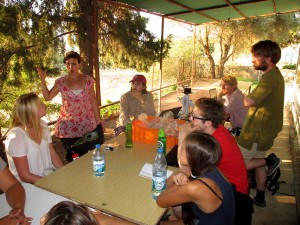(guest post by Megan Daniels, Kilian Mallon, and Matthieu Abgrall)
Ceramic analysis at Burgaz centers on the study of both forms and fabrics of pottery. Goals for this analysis in 2013 focused on identifying the range and variety of local ceramic traditions around Burgaz and its territory as well as taking the first steps towards quantifying long-term trends in the import and export dynamics of an eastern Mediterranean maritime center. Recently we have focused mainly on visually identifying a range of local fabric groups within the excavation assemblages and developing a reference collection with which to sort incoming assemblages according to fabric type. Last season Megan developed this reference collection along with accompanying fabric descriptions and XRF analyses; in 2014 our goal is to further test and refine the collection through (a) identifying and testing the fabrics of dateable diagnostic sherds and (b) comparing fabrics at Burgaz both visually and chemically to fabrics from surrounding pottery workshops.

Megan discusses some of the nitty gritty of identifying shapes and fabrics within the local ceramic repertoire.
After ceramic finds come in from the field, we spend desalinate them before laying them to dry. At that point they are first sorted into functional groups (amphora, common ware, fine ware, cooking ware, and tile/brick/pithos) based on size, form, and coarseness of the fabric. Each of these groups represents some type of human activity. For example, amphoras usually indicate transport and trade of agricultural products. Common wares were for day-to-day dining and serving. Fine wares did more or less the same job, but were for special occasions. Cooking ware was for cooking, and usually contains more temper to keep the pot intact under repeated thermal stress.
Next we record the number of diagnostic sherds (rims, bases, handles) in each group, we count the number of sherds, and we weigh each group. Some of our lots could fit in your hand, and some stretch over three big crates. The next stage is to re-sort the amphora and common ware sherds by fabric group, of which we currently have ten. We look at the type of clay paste, the porosity, the type and density of inclusions and temper, the color, how it broke, and the coarseness under a small hand-held 10x microscope. Once again we count and weigh each group. Meanwhile, we take out and examine diagnostic sherds so that we can pin down a feature to a period or place of origin. For example, cone shaped amphora toes with a prominent ring were made in the Knidos area from the 3rd century BC to the 2nd century AD.
From visual analysis, we move to elemental analysis with a portable x-ray fluorescence tracer (pXRF), the topic of our next post…

